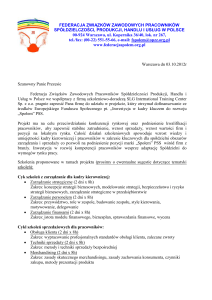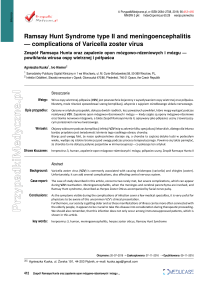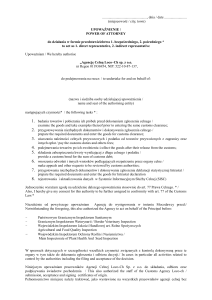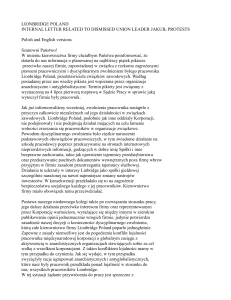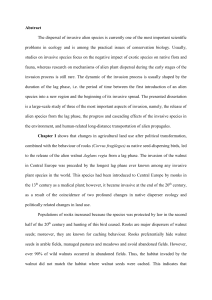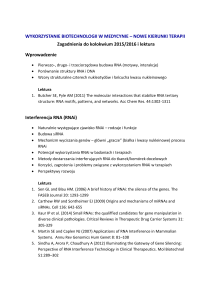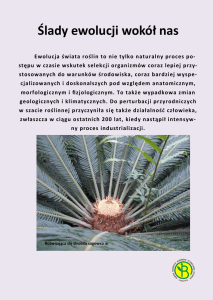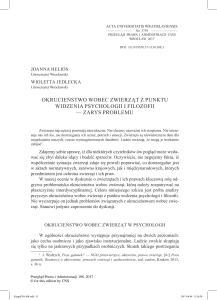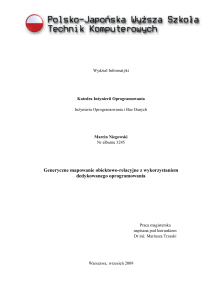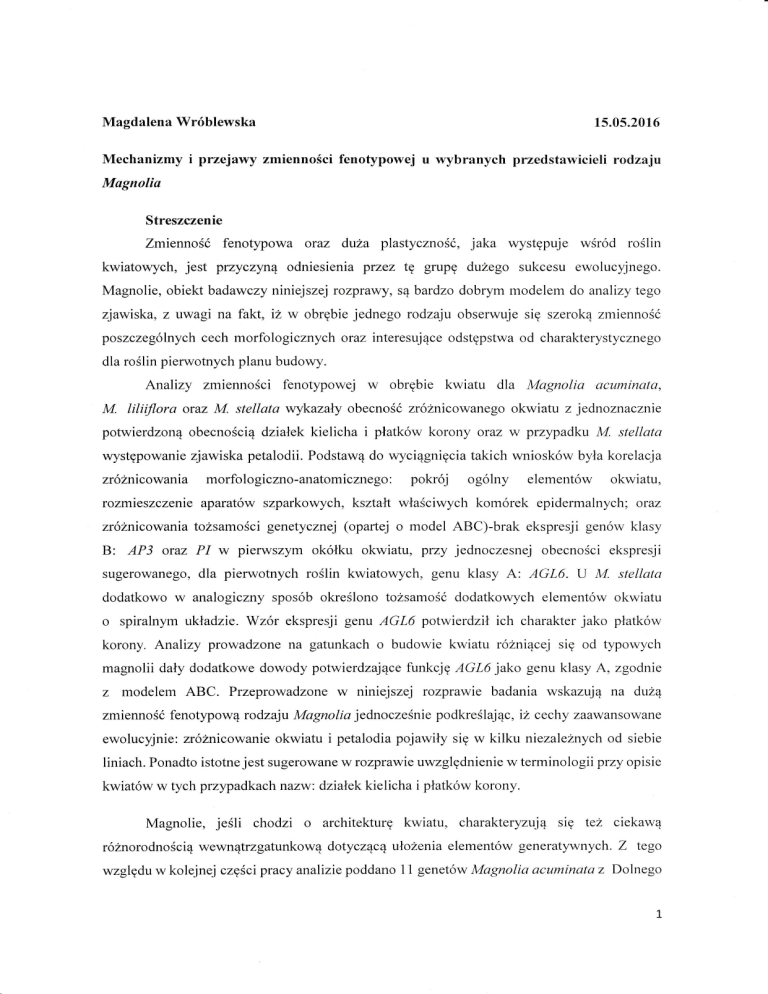
Magdalena Wróblewska
15.05.2016
Mechanizmy i przejawy zmienności fenoĘporvej u wybranych przcdstarvicieli rodzaiu
Magnolia
streszczenie
Zmiennośó fenotypowa oraz duża plastyczność, jaka występuje wśród roślin
kwiatowych, jest przyczyną odniesienia przez tę grupę dużego sukcesu ervolttcyjrrego.
Magnolie, obiekt badawczy niniejsze.i rozprawy, są bardzo dobryrn nrodelellr do analizy tego
zjawiska,
z uwagi na fakt, iż w
obrębie jednego rodzaju obserwuje się szeroką ztlrienność
poszczególnych cech rnorfologicznych oraz interesu.iące odstępstwa od charakterystycznego
dla roślin pierwotnych p|anu budowy.
Analizy zmienności fenotypowej
M. liliiflora
w
obrębie kwiatu dla Magncllia 0culninttlct,
oraz M. stellala wykazały obecnośćzróżnicowanego okr,viatu z jedtrozllaczllie
potwierdzorlą obecnością działek kielicha
i
płatków koron,v oraz w przypadku M. stellata
występowanie zjawiska petalodii, Podstawą do wyciągnięcia takich r,vtliosków b),ła korelacja
zróżnicowania morfologiczno-anatomiczllego: pokrój ogólrry elenreIrtórł,
okr,viatu,
rozmieszczenie aparatów szparkowych, kształt rvłaściwyclrkorrrórek epidermalrlyclr; oraz
zróżnicowania tozsamościgenetyczne.| (oparlej o model ABC)-brak ekspresji genórł, klas1,
B: AP3
oraz
sugerowanego.
PI w pierwszym
okółktr okwiatu. przy jednoczesnej obecności ekspresji
dla pierwotnyclr roślin kwiatorvl,clr, genll klas,v A: AGL6. U
X.I.
stellala
dodatkowo r.l, analogiczny sposób okręślonotozsanrośćdodatkor,vyclr elerneIltólv okwiatu
o
spiralnyln układzie. Wzór ekspresji genu AGL6 potwierdził iclr cl'arakter jako płatkótł,
korony. Analtzy prowadzone na gattlnkach o budor,vie krł,iatu rózniące.j się od
t,vpou,1,,clr
magnolii dały dodatkowe dowody potwierdzające funkcję AGLó jako genu klasy A. zgodrric
z
modelem
ABC. Przeprowadzone lv niniejszej rozprarvie badania lvskazrtją na
dtlżą
zmiennośćfenotypową rodzaju Magnolia.jednocześnie podkreślając,iz ceclry zaawansowane
ewolucyjnie: zróżnicowanie okwiatu i petalodia pojawiły się rv kilku niezależnych od siebie
liniach. Ponadto istotne jest sugerowane w rozprarł,ie ur,vzględrrienie w terminologii przy opisie
kwiatólł,w tych przypadkach nazw: działęk kielicha i płatków korony.
Magnolie,
jeślichodzi o
architekturę kwiatu, clrarakteryzu.ią
się też ciekar,vą
róznorodnością wewnątrzgatunkową dotyczącą ułozenia elementów generatywnych.
względu w kolejnej części pracy analizie poddano 11 genetów Magnolia acttmin.ata
z
Z
tego
Dolnego
Śląska w kontekście spektrum wzorów filotaktycznych słupkowia. Stwierdzona zmiennośó u
tego gatunku jest bardzo duża, świadczy o tym fakt oznaczeniałącznie 14 różnych wzorów, w
tym wzoru <I,3,7,I0,...,>, który był kwestionowany, jako niemożliwy do wystąpięnia w
naturzę. Ana|izy związane
z
powtarzalnością u poszczególnych genetów spektrum wzorów w
kolejnych dwu latach pokazały, że w ttzech na cztety analizowane przypadki spektrum w
kolejnym roku kwitnienia powtórzyło się. Jednak dla pełnego potwierdzęnia obecności
zjawiska,,odcisku pa|ca",potrzebne byŁyby znacznie szersze, wieloletnie badania
Zmienność fenotypowa opisana została również na przyVJadzię tkanki przewodzącej,
drewna wtórnego (typów członów naczyń, rodzaju jamkowania, modyfikacji płF
perforacyjnych)
u
13 gatunków aklimatyzowanych w Polsce. Andrizie poddano łatwiej
dostępny mŃeriał, wcześniej w literaturze niebadany, jakim
W
są odgałęzienia boczne.
odniesieniu do literatury, w której opisy tkanki dotyczą pnia głównego, zaobserwowano
występowanie innych typów członów naczyh, gatunkowo charakterystycznych. Stąd
w niniejszej rozprawie
zaproponowano, aby klucze taksonomiczne oparte na budowie drewna
o informacje na temat charakterystyki tkanki pochodzącej
również z odgałęzień bocznych, gdy w niektórych przypadkach moze to prowadzió do
wtórnego zostŃy rozszęrzone
błędnego oznaczęnia gatunku.
Badania zawattę w niniejszej pracy są ważnym krokiem w kierunku zrozumięnia relacji
między potencjałem jaki daje genotyp a róznorodnością morfologiczną oraz możliwlłrni
kierunkami rozwoju cech strukturalnych.
W*
WŃ*,^^l,^u
Magdalena Wróblewska
15.05.2016
Mechanisms and expressions of phenoĘpic variation in selected representatives of the
Magnolia genu§
Abstract
Phenotypic variability and high plasticĘ, which occur among flowering plants, are the
reason for this gloup's achievement of large evolutionary success, Magnolias, the case study
of
this work, provide a very good model to analyse this phenomenon. This is due to the fact that a
wide variation of particular morphological features and interesting exceptions from the
characteristic plant architecture are observed within one gęnus.
The analysis of the phenotypic variation within the flowers of Magnolia acuminata, M.
liliiflora and M. stellata showed the presence of differentiated perianth with a clearly
distinguished sepals and petals and, in the case of M. stellata, the occurTence of thę petalody
phenomenon. Thę basis for reaching these conclusions was the correlation between the
morphological and anatomical diversity in example the overall appearance of the perianth
elements, the arrangement
of stomata and also the shape of thę epidermal cęlls.
observations lęd to further analyse the genetic identity (based on thę
ABC
These
model). The lack
of
expression of the B-class genes (AP3 and P1) with the simultaneous expression of AGL6,
postulated as the A-class gene for the ancient flowering plants, in the first whorl of perianth
confirmed the previous results. In addition, in M. stellata, thę identity of the spirally-arranged
additional perianth elements was examined in an analogous manner. The patterrr of the
AGL6
gene ęxpression confitmed their character as petals. The analyses carried out on the species
with a differęnt flowęr structure than that typical of magnolia gave additional evidence of the
AGL6 gene function as an A-class gene, in accordance with the ABC modęl. Analyses
conducted
in this work showed high phenotypic variation within the Magnolia
genus,
simultanęously highlighting that the evolutionarily advanced features, differentiated perianth
and petalody phenomenon appeared in sęvęral independent lines. It is also important to take
into account the suggested terminology when describing the flowers' elements in these cases:
sepals and petals.
With regards to the architecture of the Magnolia flower, it is also charactęrised by an
interesting intraspecies' diversity of the arrangęment of generative elements. Therefore, irr thc
subsequent paft of the study,
1l
genets of Magnolia acuminata frorn Lorver Silesia (in the
context of the phyllotactic patterrrs spectrum) were analysed. The variation found in this species
is very high, evidenced
by l4 different marking patterns, including pattern
<
1
.3,7, l 0, ...> r,r,hiclr
was questioned as being impossible to occur in nature. Analyses regarding tlre repeatability of
individual genets spectrum patterns in the followirrg two years showed that in thrcc oLrt of tlłc
four cases analysed, tlre spectrum repeated in the subsequent flowering season" I,iowever, for
full confirmation of the presence of the phenomenon of "fingerprint", muclr broader. long-term
studies would be necessary.
Phenotypic variability has also been described on the example of vascular tisstte, the
secondary xylem (types of the vessels members, intravascular pitting, modifications in the
perforation plate morphology) in
l3
species reintroduced in Poland. Side branches as more
readily available material, previously not presented in the literature, r,vere anall,secl. Regarding
the literature, with descriptions of the tissue of the main trunk, other types of spccics-specific
vessel members were observed. Thus, in this work. it was suggested that thc taxonomic kcysbased on the structure of the secondary xylem - should be extended witlr inforrr,ation aboLlt the
characteristics of the tissue also derived fiorn the side branches as. in some cases. this carr lead
to the wrong identification of the species.
Thę research presented in this doctoralthesis is an important step towards understanding
the relationship between the potential given by the genotype and the variety of rnorplrology arld
possible tendencies in the development of structural features.
bblll,,łr,,r,ł^z

